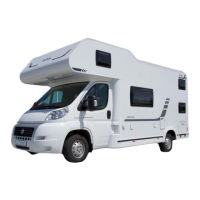12-14
If, despite all of these measures, con-
densation forms somewhere, simply
wipe it away.
The following applies for containers:
• If the interior is sufciently heated, the fresh
water tank, water pipes and therme/boiler
should not freeze. Fill all of the water contai-
ners only after the interior has been thoroughly
heated.
• Since waste water is collected outside the ve-
hicle, add antifreezer or common salt to it. The
drain cock of the sewage pipe must be kept
clear.
• The toilet can be used normally, even in cold
weather, as long as the interior of the camper
is heated. If there is a danger of frost, both the
excrement and the ushing water tanks should
be emptied.
The following applies for ventilation:
During operation in winter, condensation is
caused when using the camper in low tempera-
tures. Sufcient ventilation is extremely impor-
tant to ensure that the quality of the air inside
the camper is good and to avoid damages to
the vehicle caused by condensation.
• Do not shut vents for forced ventilation.
• Set the heating to maximum power when he-
ating up the camper. Open stowage spaces,
cupboards, drawers, furniture aps, curta-
ins, shades and plissés. This enables you to
achieve optimum ventilation and de-aerating.
• Only heat the camper when the recirculation
air system is switched on.
• Every morning, air all of the cushions, mattres-
ses and stowage spaces and dry any damp
spots.
• Air thoroughly with fully opened doors and
windows several times a day.
• If the outside temperature is under 8° C, win-
ter covers should be mounted over the venti-
lation grilles of the refrigerator.
• The camper uses considerably more gas in
winter than in summer. Two 11 kg bottles of
gas will be used up in just under one week.
• Therefore, should you stay longer in one place,
it is worthwhile to set up an outer tent. It will
help to acclimatise the camper and keep the
dirt out.

